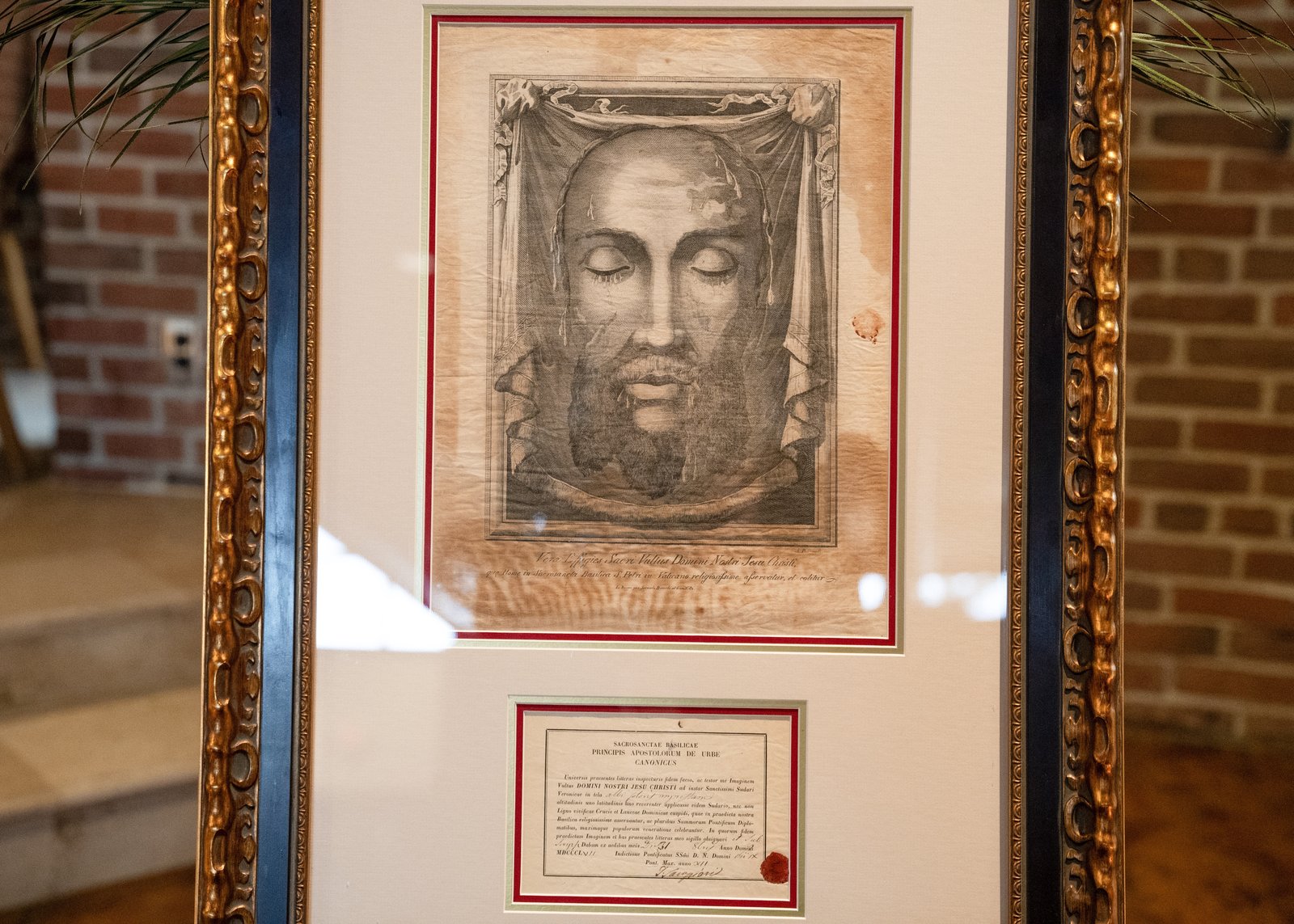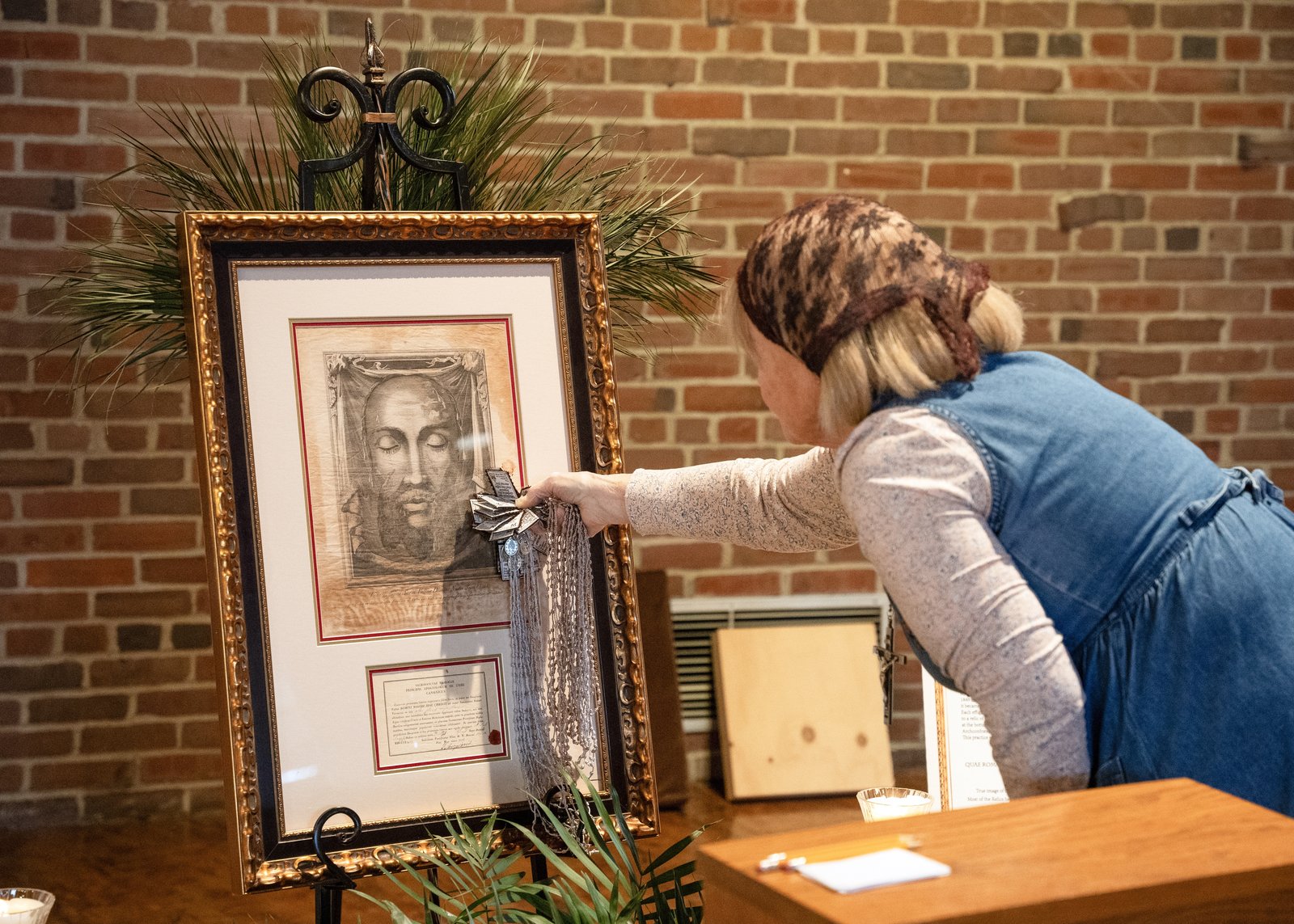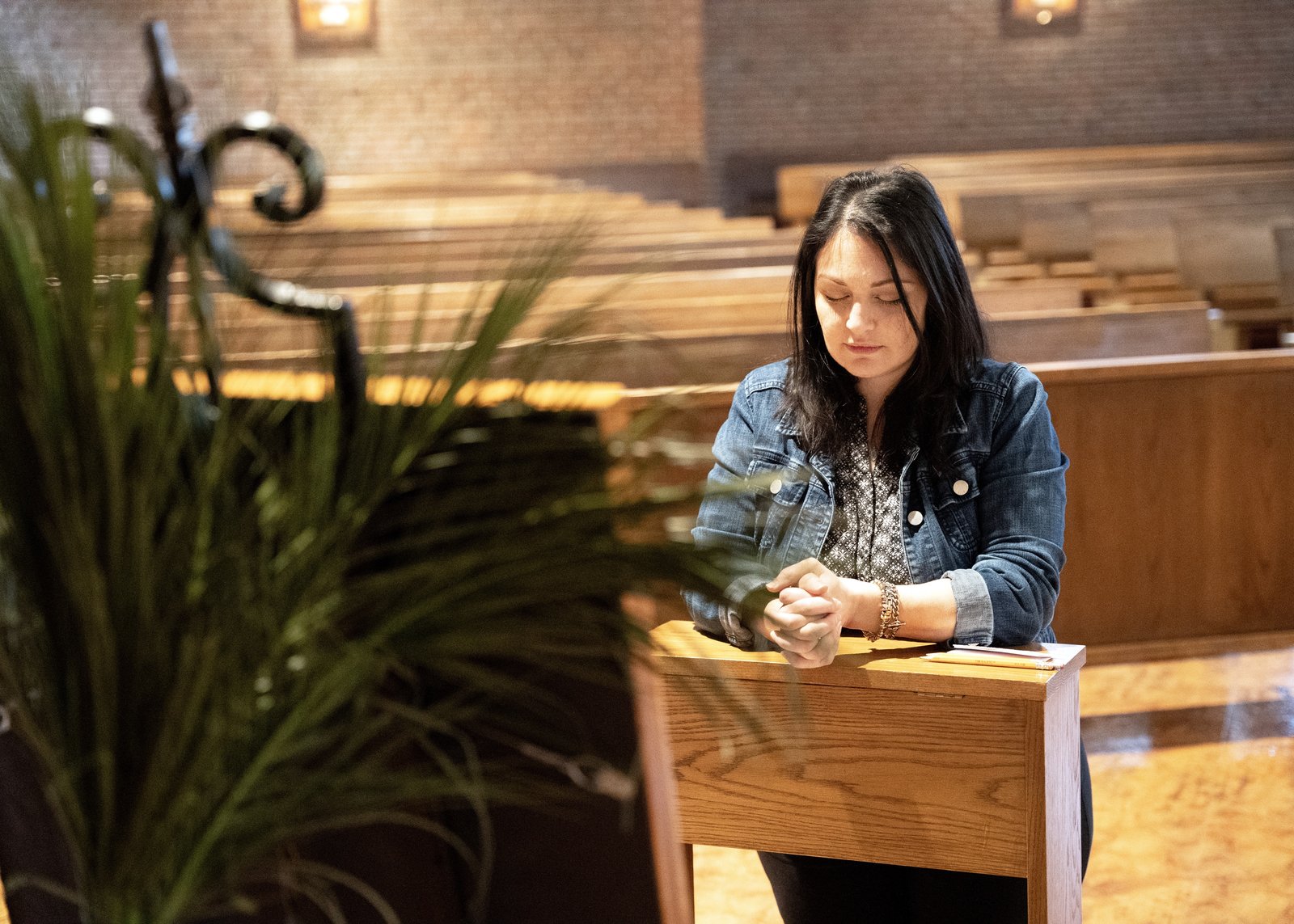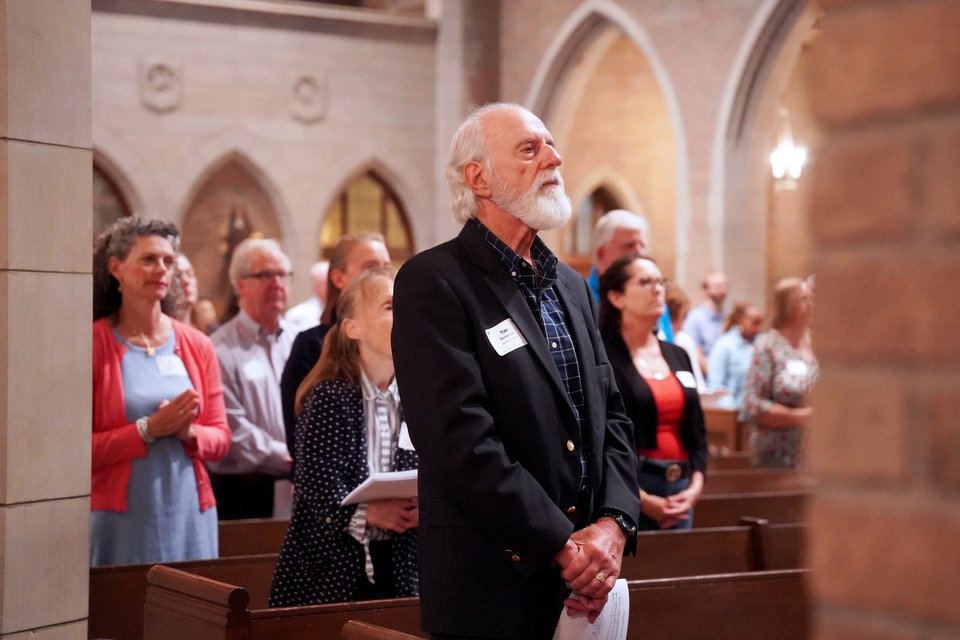The Holy Face relic, which dates back to the mid-1800s, is on display for veneration at St. John Fisher Chapel in Auburn Hills
AUBURN HILLS — In preparation for Christ’s passion and death, Catholics at St. John Fisher Chapel University Parish have the opportunity to partake in a centuries-old devotion: the oft-forgotten veneration of the relic of the Holy Face of Jesus.
The relic, which is an effigy, or model, of Christ’s face as it appears on the veil of Veronica, is one of an unknown number of images that were commissioned and stamped by the Vatican following a miracle involving the veil in the mid-1800s.
Don't miss another story
Did you know you can get Detroit Catholic's latest daily or weekly articles delivered to your inbox? It's easy and free to sign up.
The devotion to the Holy Face has surged in and out of popularity and Catholic attention for years, and is currently experiencing a revival, according to Mary Mutti, a parishioner at San Francesco Parish in Clinton Township and the caretaker for this particular image.
The story of how the devotion to the Holy Face of Jesus came to be is three-fold, Mutti said. It began in 1843 when a young French Carmelite nun, Sr. Mary de Saint-Pierre, received a series of revelations from our Lord regarding his wish for the establishment of a worldwide devotion to the Holy Face.
The purpose of the devotion was to make reparations for sins against God, particularly blasphemy, sacrilege and the profanation of Sundays and the Holy Days of obligation, Fr. Steve Mateja, priest in solidum at St. John Fisher, explained to Detroit Catholic.

“Devotion to the Holy Face has lessened,“ Fr. Mateja said. “The devotion to the Holy Face is very important, and what the devotion calls for is for reparation of the crimes against Jesus — sacrilege and blasphemy to his Holy Name. We have to repare for the wound of blasphemy, of hurting God in the world. What wounds the Lord is our lackadaisical worship on Sunday (and) that we don't love Him enough to come to church on Sunday, the day of His resurrection.”
Jesus made promises attached to the Holy Face devotion to Sr. Mary, Fr. Mateja added, and these have become part of the practice and prayers that go hand in hand with the devotion.
In his revelation to Sr. Mary, Christ said he wanted more Veronicas to come forward, Mutti added.
“Simon of Cyrene was forced to help Jesus, but Veronica stepped out of the crowd because she recognized the face of God,” Mutti explained to Detroit Catholic. “She could have been killed, but she stepped out of the crowd and gave him what she could in that moment, which was to wipe his face.”
Most of the Stations of the Cross involve people doing everything they could to destroy Jesus, but Veronica stands out as one of the few who helped, Mutti said.
“What she did is a model for all of us to look for Jesus’s face in people we see and run into in our lives — people who are sick and struggling or have lost their faith,” Mutti said. “We have to be the Veronicas to show the face of God and let them know that they are not abandoned.”
Sr. Mary died in 1848, but in 1849, the rendering attached to the devotion was revealed. The Holy Father, Pope Pius IX, had fled Rome due to a revolution that threatened Catholicism. He ordered public prayers in all churches, beseeching God for mercy on the Papal States. The relic of Veronica’s veil was put on exposition, and on the third day, a miracle occurred.
Those present witnessed the faint impression on the veil become more distinct and lifelike and remained like this for three hours. In recognition of this miracle, Pope Pius IX ordered detailed engravings to be made of the effigy either on linen or silk cloth. Each one included a stamp of authenticity and an inscription.
Each of these images was touched to the instruments of the Passion, Mutti added.
“They touched the instruments that were part of his passion: the veil of St. Veronica, the true wood of the Cross and the tip of the spear of St. Longinus,” Mutti said. “We know that these instruments had Christ’s blood on them, and when these effigies touched those instruments, we believed they touched his blood.”


Through the early 1900s, new images were created in the same manner every year on the feast of the miracle. The images were sent throughout the world for veneration; however, Mutti said it is unclear how many exist as some have been lost and others are kept secret by their owners because of their value.
Mutti’s charge of the relic came about miraculously.
“The relic had been discarded and was found and given to a husband and wife team who own a printing shop in St. Clair Shores,” Mutti explained. Mutti had been a client of the couple for years.
“(The wife) is Lutheran and didn’t know what it was until she did some research,” Mutti explained. “Through prayer, they called me and said they would like to give the relic to me. They gave it to me with the understanding that it would go into a church.”
Today, Mutti lends the relic to churches across the country for veneration, and in the times between, it is in her care.
Modern devotion and the connection between the miracle with the veil of Veronica and the revelations given to Sr. Mary would not have been possible without a third player.
Venerable Leo Dupont, a wealthy Frenchman and friend of Sr. Mary’s during the time of the revelations, used his wealth and power to propagate the devotion, even after Sr. Mary’s passing. Venerable Dupont was given two of the images created in the Vatican, one of which he kept on display in his home with an oil lamp perpetually burning in front of the image. He prayed the devotion prayers that had been given to Sr. Mary and invited others into his home to participate. Word spread and countless miracles occurred through prayers and devotion to the Holy Face.
In 1885, nearly 10 years following the death of Venerable Dupont, the existence of the Holy Face image, in combination with the prayers given to Sr. Mary and the miracles that occurred in Dupont’s home, led Pope Leo XIII to establish the devotion as an archconfraternity for the whole world — an unprecedented act.
The confraternity is still active today and counts the family of St. Thérèse of Lisieux among its members.
This is the second consecutive year that the Holy Face relic has been on display in St. John Fisher’s sanctuary during Holy Week, Fr. Mateja said. He hopes to bring it back every year.
Fr. Mateja credits this newfound tradition and devotion at the parish, which also serves students at nearby Oakland University, to the personal devotion of a St. John Fisher parishioner, Judie McGuire, who also serves as director of religious education at the parish and arranged for the relic's visit. McGuire first heard of the devotion years ago, but says she knew very little and didn’t practice the devotion until 2022, when a friend gifted her a book about Venerable Dupont for Christmas.
“It is really very providential — I didn’t want to read it, but I started reading, and it opened up the doors for my awareness of this devotion,” McGuire told Detroit Catholic.
McGuire became fascinated with the story, particularly with the oil lamp Dupont kept burning under the image, which had also been used to bless people.
“I had a friend who was dying at the time from pancreatic cancer in her early 50s, and I felt the Lord put on my heart that I should try to find this oil,” McGuire said. “I went online to find more and came to a dead end and said, ‘Lord, if you want this, then you are going to have to bring it to me.’ I continued to pray the devotions and ask the Lord to provide whatever He wanted.”
Several weeks later, McGuire was on the phone with her mom, who without knowing of McGuire’s personal quest for the oil, had acquired a bottle of it from a friend who had one of the Holy Face effigies in their home.

McGuire planned to reach out to the friend to ask for some oil, but before she could do so, she received another call from her mother: while having breakfast the next day with another set of friends who owned a Catholic bookstore, McGuire’s mom had shared the story. The friends told her that they had several bottles and would give one to McGuire.
“I got the oil in March 2023, and I was absolutely astounded. I don’t know why (I was astounded because) God is always so good, and it is not that He doesn’t provide, but I am always in awe when He does. He put it on my heart to find it, and He literally brought it directly to my feet,” McGuire said.
McGuire’s friend has since passed away, but not before she had an opportunity to receive the oil and venerate the relic of the Holy Face.
“She suffered immensely, but she said it was comforting to her that the Lord was walking with her through this suffering, and she felt comforted by the oil,” McGuire added.
For McGuire, the Holy Face Relic serves as a reminder that we have a God who loved His children enough to suffer on the Cross and save humanity from its own sin and suffering.
“He doesn’t leave us alone in that suffering,” McGuire said. “We can draw very close to Him in His passion and suffering and see something beautiful in the heart of the Father who gave us the Son and see what He is willing to do for us. It is my hope that people will deepen their faith and deepen their relationship with our Lord through an encounter with Him (through the Holy Face devotion) as they meditate on His passion and suffering."
Not many people know of this devotion, McGuire said, but through the rediscovery of the many devotions that the Catholic faith offers, people can find new ways to engage and deepen their faith through a devotion that speaks to their heart.
“It is really beautiful that heaven gives us these things so we can draw closer to the God who loves us. He wants our hearts, so I think He does these things to draw us closer to Him,” McGuire added. “I am grateful for the opportunity to shed light on this one.”
The Holy Face relic will be in St. John Fisher Chapel University Parish through Good Friday. The sanctuary will be open 9 a.m. to 9 p.m. every day.
Copy Permalink
Liturgy and devotions












